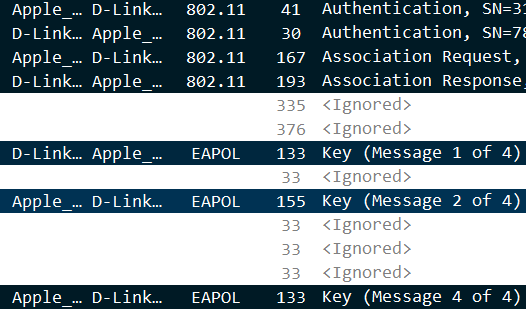1
I mean this. Firstly I've connected to my iPhone to my D-Link router :

And then I've moved to another floor and was reasonably connected to my another ZyXEL router that was closer:

Authentication frames are always type 0 (open auth) nowadays and Association ones consist of information about NIC of the STA, but while roaming process in all of the types of security (Open, WEP, WPA2) there is exchange with authentication frames and reassociation frames between STA and AP.
So my questions are:
- Why have not IEEE included information, that is contained in Association frame, into the Authentication frame? There wouldn't have been a necessity in Association frame exchange and thus roaming would have been faster a little.
- The disassociation frames exist. Okay, I understand: the STA must notify the AP with message "good bye, I'm moving to another girl". But what is the purpose of RE-authentication frames then?
Note, AFAIK, WPA actually uses the "Open" authentication type and speaks EAPOL separately from that. The only other type, "Shared-key", seems to be a relic from WEP days. – user1686 – 2016-06-20T08:38:44.610
@grawity Thank's for the comment. I decided to rename the question. Yes, I know, that historically there were authentication frames for there direct purpose, but they have not manage that. But I can not understand what is the purpose now of both authentication and association frames, especially while roaming? – heyjohnnyfunt – 2016-06-20T22:13:46.217
Why are you asking about "RE-authentication" frames? No such frame type exists. Did you mean to write "reassociation"? – Spiff – 2016-06-22T07:02:39.417
@Spiff I know. I've meant not the type of frames exactly, but the processes, that occur while roaming. And in case of reassociation the designations have coincided. – heyjohnnyfunt – 2016-06-22T08:39:56.247